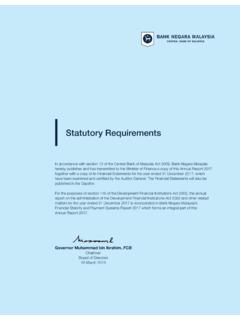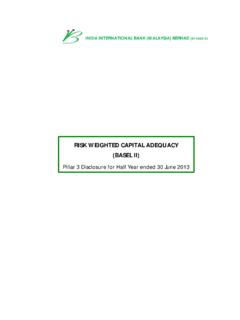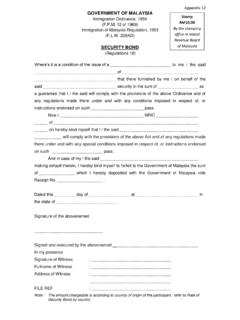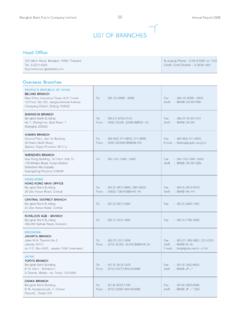Transcription of Issues in the Governance of Central Banks, May 2009
1 Issues in the Governance of Central Banks A report from the Central bank Governance Group Chair: Guillermo Ortiz, Governor of the bank of Mexico May 2009 Electronic version; contains minor updates up to 25 May 2009. Copies of publications are available from: bank for International Settlements Press & Communications CH-4002 Basel, Switzerland E-mail: or Fax: +41 61 280 9100 and +41 61 280 8100 bank for International Settlements 2009. All rights reserved. Brief excerpts may be reproduced or translated provided the source is stated.
2 ISBN 92-9131-791-8 (print) ISBN 92-9197-791-8 (online) Issues in the Governance of Central Banks iii Project Origins and Contributors Origins This project and report were initiated by the Central bank Governance Group. The report draws heavily on an extensive body of survey data and other information contributed by Central banks and monetary authorities belonging to the Central bank Governance Network (currently 47 members see the Annex for a list). Under the guidance of the Governance Group and an advisory panel, the report was prepared by the Secretariat of the Central bank Governance Forum (which comprises the Group and the Network) together with consultants engaged by the bank for International Settlements.
3 Contributors Chairs of the Central bank Governance Group during the preparation of the report Guillermo Ortiz, bank of Mexico Joseph Yam, Hong Kong Monetary Authority Members of the Central bank Governance Group during the preparation of the report Stanley Fischer, bank of Israel Mervyn King, bank of England Donald Kohn, Board of Governors of the Federal Reserve System Ian Macfarlane, Reserve bank of Australia Tito Mboweni, South African Reserve bank Lucas Papademos, European Central bank Y V Reddy, Reserve bank of India Tarisa Watanagase, bank of Thailand Zeti Akhtar Aziz, Central bank of Malaysia Zhou Xiaochuan.
4 People's bank of China Advisory panel Consultants Alan Blinder Petra Geraats Sir Andrew Crockett Ellen Meade Jacques de Larosi re Bruce White Roger Ferguson Lord George Charles Goodhart Roberto Zahler Secretariat of the Central bank Governance Forum Secretary General Central Banking Studies Gavin Bingham David Archer Serge Jeanneau Anne Mackenzie Paul Moser-Boehm iv Issues in the Governance of Central Banks Acknowledgments Stephen Cecchetti, Diego Devos, M r Gudmundsson, Philip Turner and several other BIS colleagues provided comments on various drafts.
5 Editorial and publication assistance was provided by Gregg Forte, Cynthia Lloyd, Corinne Poggioli, Kaushik Jayaram and Louisa Wagner. During a stay at the BIS as a Technical Adviser, Wojciech Kolodziej carried out a systematic analysis of Central bank laws that was useful for the project. Members of the Central bank Governance Network provided extensive support, supplying information and commenting on drafts. Final responsibility for the contents of the report lies with the authors. Issues in the Governance of Central Banks v Preface This report presents Issues that arise when decisions need to be made on the Governance of Central banks.
6 It draws on a large body of information on the design and operation of Central banks that the BIS has brought together since it initiated work on Central bank Governance in the mid-1990s. Preparation of the report required resolving several Issues . One issue is that Central banks differ significantly in the scope and nature of their functions, in their history and in the political and economic conditions in which they operate. What is suitable for one country will not be for another. Hence, setting down a single set of best practices is not feasible.
7 The report therefore eschews such an endeavour and instead seeks to present information that will help decision-makers set up Governance arrangements that are most suitable for their circumstances. A range of Governance practices is presented including some less commonly used but presentation does not imply endorsement. A second issue is the evolving nature of Central banking. The role of Central banks has changed significantly since the first one (the forerunner of today s Sveriges Riksbank) was established in 1668.
8 Changes have often taken place in response to severe crises or persistent policy problems. For example the need to deal with chronic inflation in the 1970s and 1980s prompted the identification of price stability as a formal Central bank objective and led to a significant reworking of Governance arrangements. The global financial crisis that is now unfolding could well have equally important implications for Central banks, particularly with respect to their role in fostering financial stability. These Issues are discussed in the report, but it is far too early to know how Central banking will change as a result of the current crisis.
9 What is clear is that as the broad environment for Central banking changes, the role and Governance of Central banks will continue to evolve. A third issue concerns the appropriate amount of detail to include. Central banks are complex institutions. Providing a full complement of information relevant for all the operations of Central banks would risk burying the essential features in a mound of detail. Accordingly, the report is selective, covering eight strategic topics sequentially and in depth in Chapters 2 to 9.
10 To further ease access, the report begins with a layering of overview material: the first layer is a road map of topics to guide readers to the chapters that may be of greatest interest to them; the next is a set of highlights a brief summary of the report s main themes. Thereafter, Chapter 1 offers an overview of the most important elements of Central bank Governance covered in the rest of the report. Even more detailed information on Governance matters is available to Central banks in the extensive database that underlies this report.















